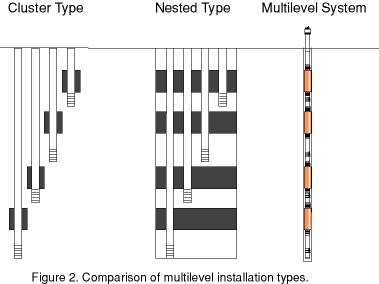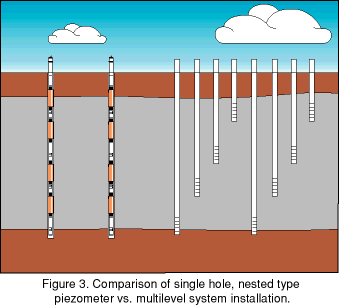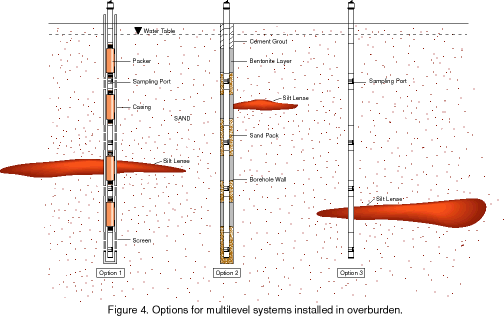Introduction

A multilevel system is a groundwater monitoring device which allows the monitoring of a number of discrete groundwater zones within the subsurface. The system consists of packers and ports which are placed at varying locations along a casing string, effectively isolating and providing access to, each monitoring interval, see Figure 1. Due to numerous benefits associated with multilevel monitoring systems, more consultants and site managers are considering them a suitable option for groundwater investigations. Previously, multilevel systems were often restricted to higher profile projects where a very high level of understanding of contaminant plume migration and groundwater flow regimes was required. In addition, they were viewed as being more costly and limited to bedrock applications. Currently with systems ranging considerably in cost (eg. a 50' multilevel with 4 zones would range from $1650 to $7300) a multilevel monitoring device can be designed to suit a much wider range of projects.
Initially, multilevel systems were created to allow delineation of contaminated groundwater in fractured bedrock (Cherry and Johnson, 1982) with the earliest systems designed for sample collection rather than full scale monitoring, including sampling, level measurements and permeability testing. Prior to advancements in multilevel instrument design this detailed monitoring was accomplished either by drilling numerous separate boreholes to various depths, often referred to as a cluster type installation, or by installing a series of piezometers at different depths in a single borehole, nested type (Figure 2). The single hole, nested type piezometers were introduced to limit costs and disturbance to the aquifer, see Figure 3. However, uncertain seal placement resulting in possible interconnection between monitoring zones resulted in the EPA (1986) stating that "Information obtained on multiple piezometer placement in a single borehole may generate erroneous data". Cluster type installations, subsequently, became the more popular approach. Todays modular type multilevel monitoring installations are continually increasing in reliability, with improvements in the integrity of seals, and flexibility to become the best option for the majority of projects involving groundwater monitoring.
Recent Advances

After developing permanent, engineered packers for reliable seals between monitoring zones, multilevel systems have undergone a variety of improvements and modifications. The driving force behind these changes has been to increase the reliability and flexibility of the system. Removeable packers were introduced to allow maintenance to be performed on the system and for complete removal when decommissioning sites. Removal of the monitoring system simplifies the grouting of the hole and much of the system can then be reused. Removable packers typically can be constructed for various diameters and are inflated either communally, using water pressure,or individually using inflation lines pressurized with air or water.
The use of packers, however, is limited to cased and bedrock cored wells. In order to successfully use multilevel systems in uncased overburden wells dry grouting systems have been developed. Designs utilize pressurized tanks connected to a compressor to place either dry bentonite or bentonite/sand layers at specified depths in a borehole. The precise placement of seals that is capable with these grouting systems, and the improved seal intergrity, has now enabled multilevel systems to be used with confidence in all types of subsurface conditions.
In the past, installing multilevel systems in fine silty deposits has resulted in clogging if the system is being used for long term sampling. Silty water can be drawn into the sampling port and line. Once sampling is complete, the silt within the remaining water column settles, resulting in a build up of silt at the base of the port. In order to prevent this from happening, screened multilevel ports were developed to filter out the silt prior to entry into the sample line.
For pump testing and detailed longterm monitoring, multilevel systems can be installed with dedicated pressure transducers to measure water level fluctuations. These instruments, used in conjunction with a datalogger provide real-time continuous pressure data. This advancement has simplified and increased the reliability of measurementstaken during slug or pump test monitoring, especially when using vibrating wire pressure transducers that offer greater stability than other transducer types.
Design Considerations

There are three options available when designing multilevel systems for use in overburden deposits. These are; 1) installations similar to those installed in rock, ie. the screened intervals are isolated by packers, but the device is installed within casing rather than a cored well or; 2) the borehole remains open and seals are placed using sand and bentonite layers or; 3) sampling intervals are not isolated, natural pack surrounds the ports and there is hydraulic connection between monitoring points (see Figure 4). When systems are installed in rock an important consideration and limitation is the quality of the cored hole. For a successfull installation rock boreholes must be circular, smooth and straight for best packer seal. In addition, a caliper log of rock boreholes is recommended to more precisely locate fractures.
The length and aperature of the screen, if the well is cased, should be selected carefully based on the deposits encountered. In overburden wells geophysical logging or a detailed drillers log should be used to identify monitoring zones. This will also ensure proper sizing of the packers to be used. Cased or bedrock wells should be thoroughly developed prior to installation either by swabbing and pumping individual screened sections or using a jetting tool , if the mud build up is particularly thick, as is often the case at the base of the installation.
Monitoring equipment for sampling and measuring water levels are available as portable or dedicated options. Typical dedicated equipment would include pressure transducers for measuring hydraulic head and pumps for sampling. Whether one option is preferred over another depends on budget, the static water level, and the depth at which the port is placed. The maximum depth to water level at which portable pumps and level indicators should be used is about 100'.
The number of monitoring zones installed as part of a multilevel system will be determined based on the units encountered during drilling. However, the number possible is also limited depending on the type of monitoring equipment chosen.
The controlling factor behind much of the decision making when designing multilevel systems is the cost. This will ultimately dictate the number, depth and type of installation. However, one of the main advantages of multilevel systems is its modular design which provides flexibility. Last minute modifications to the layout of the device can be made just prior to installation, if necessary.
Summary

Multilevel systems for monitoring groundwater flow and quality offer many advantages over standard single well installations. These are briefly listed and discussed below:
Data obtained from various depths at a site where only one borehole is drilled reduces the risk of creating interconnections between aquifers or causing aquifer disturbance
Significantly reduces costs related to drilling as well as field personnel in terms of time spent monitoring and sampling.
In most cases the sand pack or open area around sampling ports of a multilevel system is considerably less than the area found surrounding conventional installations with screens and sand packs. In order to ensure groundwater from the formation is sampled, the groundwater residing in the immediate area of the sampling zone must be purged. Multilevel devices can, therefore, substantially decrease the volume of water purged, and if hazardous substances are present reduce costs related to storage and disposal.
- Multilevel systems, by reducing the volume of water required for adequate purging, reduce sampling time and can provide substantial cost savings.
- Dedicated monitoring devices reduce the potential for cross contamination and aid in decreasing sampling times andcosts.
- Removal of the system is an option which simplifies grouting of the hole, if decommissioning a site, and also allows parts of the system to be reused.
- Dry grouting systems provide accurate and reliable placement of seals and sand packs in overburden installations or larger diameter bedrock holes.
- Engineered, permanent packers provide a high quality seal in rock installations and sample alteration is minimized since reactive materials such as bentonite do not come into contact with groundwater.
- Systems can be installed in angled boreholes where fracture flow monitoring is required and investigators wish to increase the likelihood of intersecting vertical fractures.
- Installation of two or more multilevel systems can provide three-dimensional data regarding a site for more accurate plume delineation and determination of groundwater flow patterns.
- Flexibility of multilevel systems has resulted in monitoring options that can be completely customized to suit not only the type of subsurface environment but also the needs of the investigation and the alloted budget.
Multilevel installations are currently designed and manufactured by only a select few companies worldwide. The advantages and discussions provided in this article apply to the majority of the various multilevel designs. Since their introduction, approximately 20 years ago, these systems have become considerably more reliable for use in longterm monitoring and have undergone major redesign to broaden the subsurface environments in which they can be successfully used. There remains little doubt that in the future this method of monitoring and sampling groundwater will become increasingly preferred.
Kirsten Cooper, MSc. Technical Sales Representative, Solinst Canada Ltd.
References
Cherry and Johnson (1982). Ground Water Monitoring and Review, Summer 1982.
United State Environmental Protection Agency (1986). RCRA Ground-Water Monitoring Technical Enforcement Guidance Document (TEGD), US Government Printing Office OSWER-9950.1.

